Abstract
Purpose
In the present study, we performed biometric characterization of the temporomandibular joints (TMJs) of clinically normal subjects.
Methods
Fifty-one healthy volunteers underwent high-resolution computerized tomography examination of the TMJs in the position of maximal intercuspidation according to a standardized protocol. Frontal and sagittal reconstructions were then performed to obtain measurements and indexes in three planes of space.
Results
Correlations are observed with age, gender, amplitude of mouth opening and presence of dental abrasion. The lateral stability index reflects the degree of mobility of the temporo-discal compartment of the joint. The coverage index reflects how much the mandibular condyle is inserted into the articular fossa and may be related to the risk of occurrence and severity of regressive remodeling phenomena.
Conclusions
This study supports the interest in examining morphological aspects of the TMJ and performing intra-articular measurements. The biometric examination of the TMJ has important applications in the domain of TMJ pathology.


Similar content being viewed by others
References
Blaschke D, Chase DC (1984) Differences in TMJ condyle-temporal relationships in normal men and women. Dental Res 63:266–272
Blaschke DD, Blaschke TJ (1981) Normal TMJ bony relationships in centric occlusion. J Dent Res 60(2):98–104
Costa AL, Yasuda CL, Appenzeller S et al (2008) Comparison of conventional MRI and 3D reconstruction model for evaluation of temporomandibular joint. Surg Radiol Anat 30(8):663–667
Dermirjian A (1967) A study of the morphology of the glenoid fossa. Natl Mus Can Bull 206:1–25
Dorier M, Spirgi M, Nicolas GM (1967) Variations of the inclination of the anterior wall of the glenoid cavity of the temporal bone according to age, sex, dental abrasion, and total loss of teeth. SSO Schweiz Monatsschr Zahnheilkd 77(11):968–985
Dumas AL, Oaddab MB, Homayoun NH, McDonough J (1986) A three-dimensional developmental measurement of the temporomandibular joint. Cranio 4(1):22–35
Fujii N, Yamashiro M (1981) Computed tomography for the diagnosis of facial fractures. J Oral Surg 39(10):735–741
Helms CA, Vogler JB 3rd, Morrish RB Jr, Goldman SM, Capra RE, Proctor E (1984) Temporomandibular joint internal derangements: CT diagnosis. Radiology 152(2):459–462
Hesse JR, Hansson TL (1988) Factors influencing joint mobility in general and in particular respect of the craniomandibular articulation: a literature review. J Craniomandib Disord 2(1):19–28
Hsieh HH, Walker PS (1976) Stabilizing mechanisms of the loaded and unloaded knee joint. J Bone Jt Surg Am 58(1):87–93
Liedberg J, Westesson PL (1988) Sideways position of the temporomandibular joint disk: coronal cryosectioning of fresh autopsy specimens. Oral Surg Oral Med Oral Pathol 66(6):644–649
Mafee MF, Kumar A, Tahmoressi CN, Levin BC, James CF, Kriz R et al (1988) Direct sagittal CT in the evaluation of temporal bone disease. Am J Roentgenol 150(6):1403–1410
Oberg T, Carlsson GE, Fajers CM (1971) The temporomandibular joint. A morphologic study on a human autopsy material. Acta Odontol Scand 29(3):349–384
Pullinger A, Hollender L (1985) Assessment of mandibular condyle position: a comparison of transcranial radiographs and linear tomograms. Oral Surg Oral Med Oral Pathol 60(3):329–334
Pullinger AG, Hollender L, Solberg WK, Petersson A (1985) A tomographic study of mandibular condyle position in an asymptomatic population. J Prosthet Dent 53(5):706–713
Pullinger AG, Solberg WK, Hollender L, Guichet D (1986) Tomographic analysis of mandibular condyle position in diagnostic subgroups of temporomandibular disorders. J Prosthet Dent 55(6):723–729
Pullinger AG, Bibb CA, Ding X, Baldioceda F (1993) Contour mapping of the TMJ temporal component and the relationship to articular soft tissue thickness and disk displacement. Oral Surg Oral Med Oral Pathol 76(5):636–646
Rieder CE, Martinoff JT (1984) Comparison of the multiphasic dysfunction profile with lateral transcranial radiographs. J Prosthet Dent 52(4):572–580
Rosenberg HM, Graczyk RJ (1986) Temporomandibular articulation tomography: a corrected anteroposterior and lateral cephalometric technique. Oral Surg Oral Med Oral Pathol 62(2):198–204
Sakuda M, Tanne K, Tanaka E, Takasugi H (1992) An analytic method for evaluating condylar position in the TMJ and its application to orthodontic patients with painful clicking. Am J Orthod Dentofacial Orthop 101(1):88–96
Savoldelli C, Bouchard PO, Loudad R et al (2012) Stress distribution in the temporo-mandibular joint discs during jaw closing: a high-resolution threedimensional finite-element model analysis. Surg Radiol Anat (Germany) 34(5):405–413
Seward FS (1976) Tooth attrition and the temporomandibular joint. Angle Orthod 46(2):162–170
Solberg WK, Hansson TL, Nordstrom B (1985) The temporomandibular joint in young adults at autopsy: a morphologic classification and evaluation. J Oral Rehabil 12(4):303–321
Touré G, Duboucher C, Vacher C (2005) Anatomical modifications of the temporomandibular joint during ageing. Surg Rad Anat 27:51–55
Vitral RW, Da Silva Campos MJ, Rodrigues AF, Fraga MR (2011) Temporomandibular joint and normal occlusion: is there anything singular about it? A computed tomographic evaluation. Am J Orthod Dentofacial Orthop 140(1):18–24
Weinberg LA (1978) An evaluation of asymmetry in TMJ radiographs. J Prosthet Dent 40(3):315–323
Weinberg LA (1979) Role of condylar position in TMJ dysfunction-pain syndrome. J Prosthet Dent 41(6):636–643
Wu CK, Hsu JT, Shen YW, Chen JH, Shen WC, Fuh LJ (2012) Assessments of inclinations of the mandibular fossa by computed tomography in an Asian population. Clin Oral Investig 16(2):443–450
Acknowledgments
The authors acknowledge the Delegation for Clinical Research of the Montpellier University Hospital for supporting this work.
Conflict of interest
There is no conflict of interest caused by this or other relationships in connection with this work.
Author information
Authors and Affiliations
Corresponding author
Rights and permissions
About this article
Cite this article
Dupuy-Bonafé, I., Otal, P., Montal, S. et al. Biometry of the temporomandibular joint using computerized tomography. Surg Radiol Anat 36, 933–939 (2014). https://doi.org/10.1007/s00276-014-1277-7
Received:
Accepted:
Published:
Issue Date:
DOI: https://doi.org/10.1007/s00276-014-1277-7




